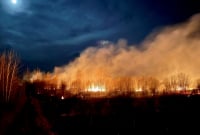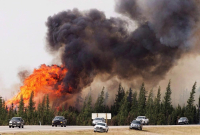Support strong Canadian climate journalism for 2025
Wildfires in Nova Scotia will put even more pressure on an already strapped health-care system, said Laurette Geldenhuys, a pathologist and professor at Dalhousie University in Halifax.
People with existing heart and lung conditions, seniors, pregnant people, and children are all particularly vulnerable to health issues from smoke inhalation. Smoke inhalation can worsen underlying conditions such as asthma, impact lung function and cause respiratory problems.
“[Wildfires] release large quantities of carbon dioxide and carbon monoxide and fine particulate matter. They also release mercury, which can cause neurological damage,” said Geldenhuys, who is also the chair of the Nova Scotia Regional Committee for the Canadian Association of Physicians for the Environment (CAPE).
There is a clear correlation between wildfires and increased hospital visits. In 2014, during the Northwest Territories’ “Summer of Smoke,” where soot filled the air for over two months, emergency room visits for asthma doubled. After looking at smoke data and ER visits, it was found to be one of the worst and most prolonged smoke exposures in the world.
In Nova Scotia, almost 13 per cent of the population is on a waiting list for a family doctor and emergency departments are stretched thin. In December, ER beds were often at 100 per cent capacity, and a woman died after waiting over six hours to see a doctor for abdominal pain at the Cumberland Regional Health Care Centre. The “enormous financial costs” that come with fighting wildfires also divert resources away from health care, explained Geldenhuys.
This week, Nova Scotia has seen unprecedented wildfires. The Maritime province has already had more fires this year than during all of 2022, and a blaze in Shelburne County, about 240 kilometres west of Halifax, is the largest ever recorded in the province. A second fire, now 50 per cent contained, started Sunday about 25 kilometres from Halifax. A total of 15 active fires in the province, four still out of control, have forced about 20,000 people from their homes, the province said Thursday. Hundreds of homes and structures have been destroyed.

At a press conference on Thursday, Nova Scotia’s Chief Medical Officer of Health Dr. Robert Strang told reporters there is “no safe level of exposure to wildfire smoke.” Everyone, especially those who are more vulnerable, should limit outdoor activity and keep their indoor air as clean as possible, he said, advising residents to keep windows and doors closed.
However, Geldenhuys noted there are people who can’t do that, like unhoused people.
“The groups of people most vulnerable are those people who are less privileged. So, they have [less] resources to recover if their house burns down or if they can't go back to work … so it is very important to keep justice in mind when all of this is looked at and remember that the most vulnerable populations would suffer most, and they have contributed least to the situation,” said Geldenhuys.
Meanwhile, a 2021 report from CAPE found that the full breadth of health impacts wildfires in general haven’t been adequately studied or prepared for. The report found Canada, Australia and Brazil are lagging behind in planning for the inevitable increase in forest fires, smoke and illness. At the same time, extreme fire risk could go up 14 per cent by 2030, 30 per cent by the end of 2050 and 50 per cent by the end of the century worldwide, according to the United Nations Environment Program.






Comments